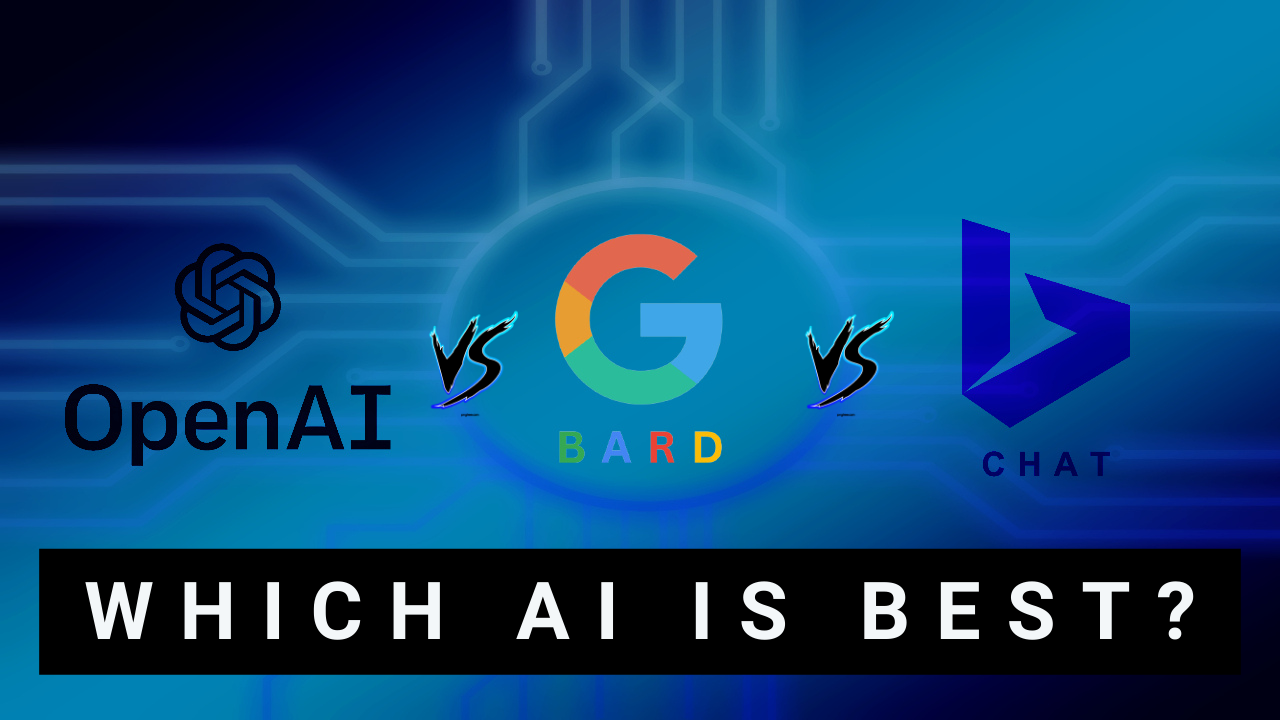Introduction
Chat GPT, Google Bard, and Bing Chat are all conversational AI systems, but they differ in terms of their capabilities, features, and the way they are built. Comparing these systems can help to understand the strengths and weaknesses of each system and identify which one is best suited for a particular use case.
OpenAI developed a huge language model called ChatGPT. It is designed to generate text like a human in reply to a given query. It has been trained on a vast amount of text data and is capable of understanding the context of a conversation to generate relevant and coherent responses. ChatGPT is often used for tasks such as chatbots, question-answering systems, and language translation.
Google BARD is the latest beta-released language model relying on improved LaMDA to generate exclusive quality text just like humans. It is almost parallel to ChatGPT. It has awesome features like fast interference speed, diverse data pre-training, cloud integration, fine-tuning, and customization.
Bing Chat, on the other hand, is a chatbot platform developed by Microsoft that allows businesses to create their chatbots for customer support and engagement. It provides tools for designing chatbot dialogs, managing conversations, and integrating with other Microsoft services such as Azure and Power Automate.
Chatbots are a game-changer for eCommerce portal. In future, businesses will experience good outcomes associated with high website traffic, customer satisfaction, increased sales, and revenue. Which AI model works for your business needs some consideration and insight. It has to be one that aligns with your online business goals and digital marketing strategies.
Which one is best?
Before we answer this question, we need to know which type of technology these AI are built with. Therefore, we will compare their technical specifications, such as the kind of NLP they use, how their language understanding system works, their conversion quality, personalization, pricing, and availability. This way, we can determine which AI is best suited for your needs.
Natural Language Processing (NLP)
Natural Language Processing (NLP) is a crucial component of many AI models, including Chat GPT, Google BARD, and Bing Chat. NLP refers to the ability of AI models to understand, interpret, and generate natural language text, enabling machines to communicate with humans more effectively.
ChatGPT:- ChatGPT is a language model that uses NLP to generate coherent and fluent human-like text responses to given prompts. GPT-3, the model on which ChatGPT is based, has 175 billion parameters, making it one of the largest and most sophisticated language models in existence. The model’s ability to understand context and generate human-like responses has made it a popular choice for chatbots, language translation, and text completion tasks.
Google BARD:- Bard is a pre-trained AI language model that uses NLP to understand natural language text and generate relevant responses. It is trained on large amounts of text data and uses LaMDA, which is trained on 137 billion parameters, to pull responses. LaMDA, or Language Model for Dialogue Applications, is a neural network-based language model developed by Google that can carry out a conversation on any topic. Google BARD has been used in various applications, including language translation, question-answering systems, and text classification.
Bing Chat:- Bing Chatbot is a chatbot developed by Microsoft that uses NLP to understand and respond to user queries. The chatbot uses a combination of machine learning algorithms and rule-based approaches to generate responses. Bing Chat uses GPT-4, a large-scale neural network-based language model, to generate human-like responses to users’ queries. It is designed to handle a wide range of queries and has been integrated into Microsoft’s search engine Bing.
In comparison, ChatGPT and Google BARD are primarily language models that can generate human-like responses, while Bing Chat is a chatbot that can provide more structured responses based on specific rules and algorithms. However, all these models leverage NLP to understand and generate natural language text, enabling machines to interact with humans more effectively.
Language Understanding
OpenAI developed ChatGPT. It is a huge language model that uses profound learning tactics to evaluate and create natural language. The model is based on the GPT structure, which is an abbreviation for “Generative Pre-trained Transformer”. It has been educated on a gigantic amount of text available from the internet. This model uses unsupervised learning to learn the patterns and relationships between words, allowing it to generate coherent and relevant responses to textual input.
BARD is another language model operating on LaMDA [Language Model for Dialogue Applications]. Google recently launched it. It is aimed to work in synch with search for providing belter responses and results to users.
Bing Chat is a chatbot developed by Microsoft that uses a combination of rule-based and machine learning approaches to understand and respond to user input. It relies on a set of predefined rules and scripts to handle common user requests, but also uses natural language processing techniques to understand more complex queries.
When comparing the language understanding capabilities of these models, ChatGPT is generally considered the most advanced due to its large size and extensive training on diverse texts. It can generate responses that are more nuanced and contextually relevant than Bards or Bing Chat.
However, Bards and ChatGPT work similarly in many ways like collecting information and offering human-like response to queries. Bing Chat, on the other hand, is designed to handle user queries in a conversational manner and can provide quick and accurate responses to common requests, but may struggle with more complex or nuanced queries.
Conversation Quality
ChatGPT, Bard, and Bing Chat are all chatbot models that use natural language processing to simulate human conversation. When it is about conversation quality each one has its range of strengths and vulnerabilities.
ChatGPT
Strengths:-
- ChatGPT is trained on a massive amount of diverse data, which enables it to generate high-quality responses to a wide variety of topics and questions.
- It has a large vocabulary and can understand complex sentences and context, making it good at maintaining a coherent conversation.
- ChatGPT can be fine-tuned for specific use cases or industries, improving its accuracy and relevance in those areas.
Weaknesses:-
- ChatGPT can sometimes generate responses that are irrelevant or nonsensical, particularly when faced with uncommon or obscure topics.
- Its responses can sometimes lack the emotional depth and empathy of human conversation.
- ChatGPT may occasionally repeat itself or struggle with maintaining a consistent topic.
Google BARD
Strengths:-
- Google BARD is designed to generate open-ended responses based on user’s input.
- It offers original and innovative concepts, viewpoints, and opinions.
- It uses minimal computing power.
- Google BARD can be customized for individual users, making it easier for them to communicate effectively.
Weaknesses:-
- Google BARD is still in its infancy so lags in accuracy.
- For fine tuning needs extra resources.
- Its size is limited in comparison to ChatGPT.
Bing Chat
Strengths:-
- Bing Chat integrates with Microsoft Teams, making it easy to use for business communication.
- It has a strong focus on customer service and can handle common support inquiries with ease.
- Bing Chat can be customized with automated workflows and integrations to streamline processes.
Weaknesses:-
- Bing Chat is optimized for a specific use case and may not be as effective in other contexts.
- It may struggle with interpreting complex or technical language, making it less effective for specialized industries.
- Bing Chat lacks the emotional depth and empathy of human conversation, which can be important in customer service interactions.
Personalization
Each of the three models, ChatGPT, BARD, and Bing Chat, have their own strengths and weaknesses when it comes to personalization for an individual user or organization:-
1. Chat GPT:- ChatGPT is a large language model trained on a vast amount of data, making it highly adaptable and able to generate coherent responses based on the user’s input. However, ChatGPT may struggle with personalization when it comes to understanding the context and nuances of a specific individual or organization, which can affect the accuracy and relevance of its responses.
2. BARD:- BARD is a conversational AI platform that utilizes machine learning to create personalized chatbots for businesses. It offers advanced customization and can integrate with existing business systems to provide tailored responses. BARD also has the ability to learn and adapt based on user interactions, making it an effective tool for personalization. However, BARD requires a significant amount of training data to achieve optimal performance, which may be a challenge for smaller businesses or organizations.
3. Bing Chat:- Bing Chat is a conversational AI service provided by Microsoft that can be customized and integrated with various platforms, such as Microsoft Teams and Skype. It offers a range of pre-built conversational templates and can be trained on specific user data to improve its accuracy and personalization. However, Bing Chat may be limited in its ability to adapt to more complex conversational scenarios or understand the unique nuances of a specific individual or organization.
While all three models have the potential to be personalized to an individual user or organization their effectiveness will depend on the specific needs and requirements of the user. Chat GPT is highly adaptable but may struggle with contextual understanding, while BARD offers advanced customization but requires a significant amount of training data. Bing Chat offers pre-built conversational templates and can be trained on user data, but may be limited in more complex scenarios.
Integration
ChatGPT, Google Bard, and Bing Chat are natural language processing (NLP) models that can be integrated with other software or systems in various ways. Here are some potentials:
- Chatbot platforms: ChatGPT, Google Bard, and Bing Chat can be integrated with popular chatbot platforms like Dialogflow, Botpress, or IBM Watson Assistant. This allows businesses to create conversational chatbots that can understand natural language and provide helpful responses to users.
- Customer Relationship Management systems: The CRM models can be integrated with CRM systems like Salesforce or HubSpot. This helps businesses to analyze customer interactions and identify trends or insights to improve their services.
- Social media management solutions: Integrating these models with social media management programs like Hootsuite or Sprout Social can help businesses monitor and respond to social media mentions and messages in real-time.
- Voice assistants: ChatGPT, Google Bard, and Bing Chat can be integrated with voice assistants like Amazon Alexa or Google Assistant to provide users with conversational experiences through voice commands.
The ease of integration for each model may vary depending on the specific use case and the software or system being integrated with. However, in general, Google Bard and Bing Chat may be more easily integrated with other Google and Microsoft services, respectively, while ChatGPT may require more technical expertise and customization to integrate with other systems. Additionally, ChatGPT may offer more flexibility and control for customization and advanced use cases.
Accuracy and Efficiency
ChatGPT, BARD, and Bing Chat are all natural language processing models designed to generate human-like responses to user inputs. Here is a brief comparison of their accuracy and efficiency:-
- ChatGPT: ChatGPT is one of the most innovative and largest natural language processing apps available. ChatGPT is highly accurate in generating human-like responses to user inputs. It achieves this by using deep learning techniques such as attention mechanisms and transformer networks. ChatGPT is also highly efficient, with response times that are typically less than a second.
- BARD: Google BARD is a state-of-the-art language model that excels at generating human-like response to natural language inputs. In terms of accuracy, the model is capable of producing responses that are grammatically correct and semantically meaningful.
- Bing Chat: Bing Chat is a chatbot developed by Microsoft that uses a rule-based approach to generate responses to user inputs. It is not as advanced as ChatGPT or BARD in terms of accuracy, as it relies on predefined rules rather than machine learning techniques. However, it is still an efficient tool for generating responses in real-time.
The accuracy and efficiency of a chat AI model depends on several factors, including the amount and quality of training data, the complexity of the natural language processing algorithms, and the speed and performance of the underlying hardware and infrastructure.
Availability and Pricing
ChatGPT:- ChatGPT 3.5 is completely free and available in almost every country. While some countries have banned it, if internet access is available, it can still be accessed from any country and you can ask any of your queries. However, it does have some paid plans like ChatGPT 4, which you have to buy before accessing. ChatGPT 4 has more parameters than ChatGPT 3 and a much better response rate.
Google Bard:- Talking about Google Bard AI, it is also completely free but has many restrictions. It’s only available in US and UK countries, and it’s still in an early stage, so it’s not yet released for the general public.
Bing Chat:- Bing Chat is completely free for personal use and is also available in almost every country. However, it does have some limitations with usage. Microsoft has limited their chat API free tier to 1000 transactions every day. After that, you have to pay for further usage.
Conclusion
Comparing these systems, we can see that ChatGPT and Bard are both language models that can generate human-like text, while Bing Chat is a chatbot platform that provides tools for building chatbots.
ChatGPT has access to internet data until 2021 reference🡕, while Google BARD was released in 2023 and so has latest information reference🡕. Bing Chat is designed for businesses that need to create chatbots for customer support and engagement.
Overall, the choice of which system to use depends on the specific needs of the user or business. Chat GPT and Bard are more suitable for tasks that require generating human-like text, while Bing Chat is more suitable for businesses that need to create chatbots for customer support and engagement.





